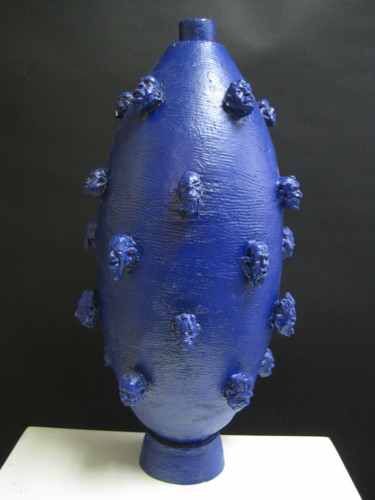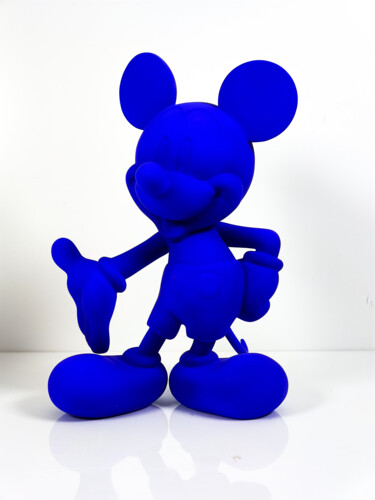 Cfey, Blue day, 2021. Acrylic on canvas, 72 x 60 cm.
Cfey, Blue day, 2021. Acrylic on canvas, 72 x 60 cm.
The meaning of the color blue
Every day we experience a sensory overload of colors, among which, blue is definitely one of the most popular and sought-after hues. But have you ever thought about the deeper meaning of this nuance? In this context, blue turns out to be, without a shadow of a doubt, a color associated with the sky and the sea, but also with deeper feelings and ideals, such as freedom, intuition, imagination, inspiration, sensitivity, depth, wisdom and emotional stability. Concerning this last point, it has been scientifically proven the beneficial influence that blue exerts on the mind, inducing the human body to produce calming and relaxing chemicals. In fact, blue favors not only psychic balance, but also the expression of one's self, since it conveys meaning, importance and confidence, avoiding instilling dark and sinister feelings. In particular, light blue is associated with health, healing, tranquility, understanding and softness, while dark blue represents knowledge, power, integrity and serenity. But how did the use of this color, in its different shades, develop within the art world?
 Stuart Dalby, From a high place, 2022. Acrylic on canvas, 76.5 x 61.5 cm.
Stuart Dalby, From a high place, 2022. Acrylic on canvas, 76.5 x 61.5 cm.
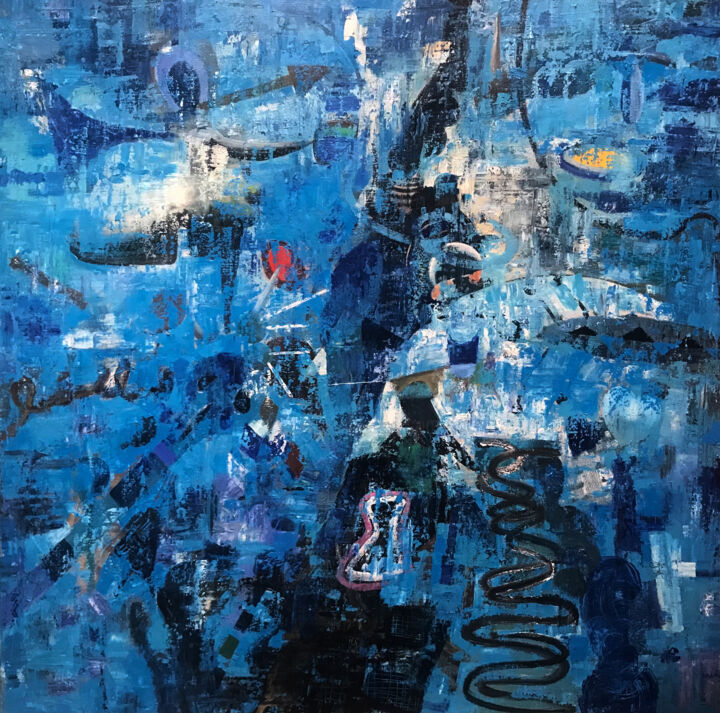 Weilong Chen, Blue perception 2, 2022. Acrylic on canvas, 160 x 160 cm.
Weilong Chen, Blue perception 2, 2022. Acrylic on canvas, 160 x 160 cm.
The color blue in the history of art
The color blue, in its different and most popular shades, such as Egyptian blue, ultramarine blue, cobalt blue, cerulean blue, Prussian blue and International Klein Blue, has been the protagonist of different eras, in which timeless masterpieces have been generated, ranging from the Egyptian world to contemporary art.
 Adalberto Miguez, Disjonction II, 2022. Oil on linen canvas, 100 x 80 cm.
Adalberto Miguez, Disjonction II, 2022. Oil on linen canvas, 100 x 80 cm.
Egyptian Blue
Egyptian blue, created around 2,200 B.C. in ancient Egypt, was the first color pigment to be produced synthetically, as it is the result of mixing a ground limestone with sand and a copper-containing mineral, then heated to between 1470 and 1650°F. The result of this process is an opaque blue glass, which, crushed and combined with thickening agents, originates a long-lasting varnish, or enamel. In the Egyptian world this color, held in high esteem, was used to paint ceramics, statues and decorate the tombs of the pharaohs. Later on, this hue, popular throughout the Roman Empire, fell into disuse at the end of the Greco-Roman period (332 B.C.-395 A.D.), when new methods of color production began to evolve. Instead, an example of the current success, and recurrence, of Egyptian blue within the contemporary art world is provided by the painting Disjonction II by Artmajeur artist Adalberto Miguez, in which expressive and realistic human bodies were painted by reference to this iconic shade.
 Yaroslav Kurbanov, A new different world, 2022. Oil / acrylic on linen canvas, 77 x 55 cm.
Yaroslav Kurbanov, A new different world, 2022. Oil / acrylic on linen canvas, 77 x 55 cm.
Ultramarine
Sometimes also called the "true blue", ultramarine is a pigment, which, derived from the semi-precious gemstone of lapis lazuli, first appeared in the 6th century, when it was used in the creation of the precious Buddhist frescoes of Bamiyan (Afghanistan). Later, "true blue" was imported to Europe by Italian traders, when, during the 14th and 15th centuries, it became the most precious, sought-after and expensive color of the medieval era. In fact, for a long time the cost of lapis rivaled the price of gold, so much so that the use of this shade in art was often reserved exclusively for the realization of the most important figures or the most lucrative commissions. This modus operandi remained unchanged until, in 1826, a French chemist invented a synthetic ultramarine, which, far cheaper, took the name "French ultramarine". Finally, it is important to highlight how the tones of ultramarine blue, which have distinguished timeless masterpieces such as Johannes Vermeer's Girl with a Pearl Earring, continue to have wide success in the world of contemporary art, as demonstrated by the painting A New Different World, by Artmajeur artist Yaroclav Kurbanov, in which this color emerges with strength and elegance in the dress of the emotional protagonist.
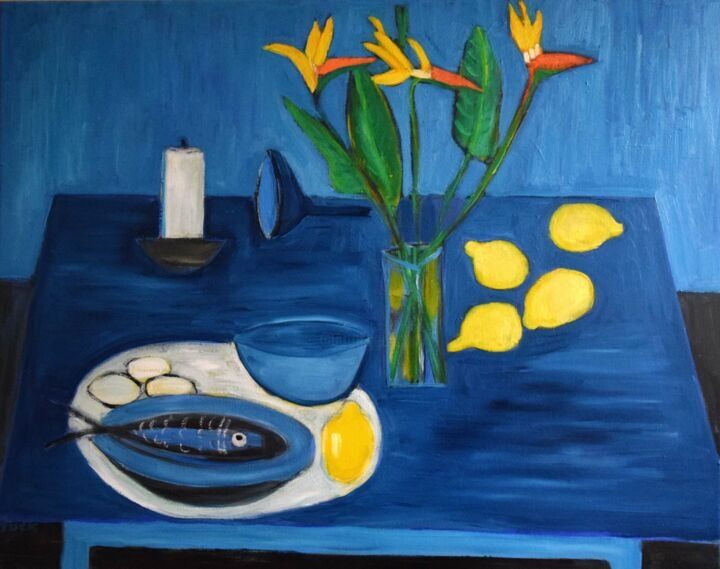 Jo Tuck, Blue still life with fish, flowers and lemons, 2022. Oil on canvas, 61 x 76.2 cm.
Jo Tuck, Blue still life with fish, flowers and lemons, 2022. Oil on canvas, 61 x 76.2 cm.
Cobalt blue
Cobalt blue, dating back to the eighth century, was initially used to color ceramics and jewelry, as in the case of the famous Chinese porcelain, decorated with the iconic blue and white patterns. Subsequently, after the discovery of the French chemist Louis Jacques Thénard (1802), a purer version of this pigment came into vogue, which, based on alumina, was used by great artists such as J.M.W. Turner, Pierre-Auguste Renoir and Vincent Van Gogh, who preferred this innovation to the more expensive ultramarine. As for the world of contemporary art, it continues to make extensive reference to the colors used by these masters, as evidenced by the still life of the artist from Artmajeur, Jo Tuck, dedicated entirely to the nuances of this shade of blue.
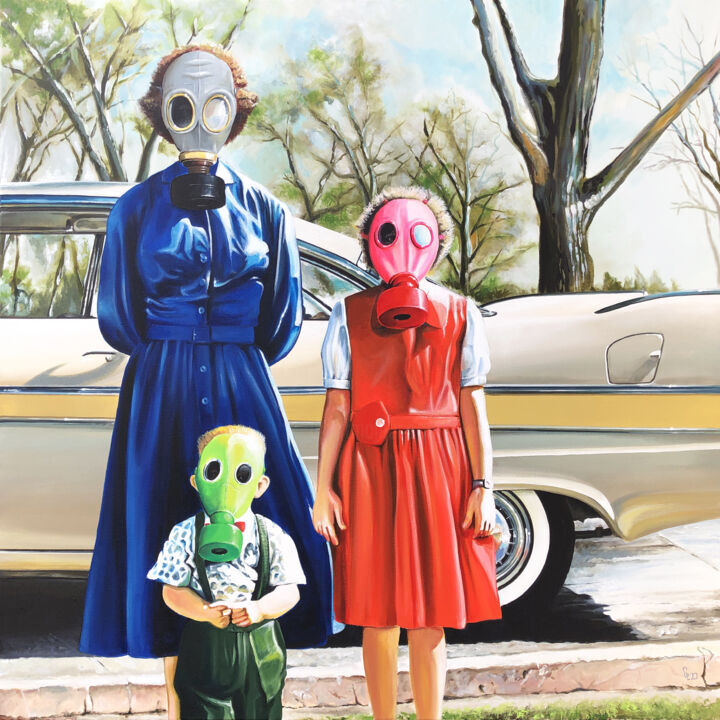 Christian Lucas, Pandemik, 2022. Acrylic on canvas, 100 x 100 cm.
Christian Lucas, Pandemik, 2022. Acrylic on canvas, 100 x 100 cm.
Cerulean Blue
Cerulean blue, a pigment originally composed of cobalt stannate and magnesium, was perfected by the research of Andreas Höpfner who, in 1805, toasted oxides of cobalt and tin. Nevertheless, the color was not available as an artistic pigment until 1860, when it began to be sold by Rowney and Company under the name coeruleum. This nuance was very popular among great artists, such as, for example, Berthe Morisot, who used this pigment, along with ultramarine and cobalt to make the coat of the woman in the famous painting Summer's Day (1887). Following the example of this great exponent of Impressionism, contemporary art also uses this shade extensively, just like one of the dresses painted in Pandemik, a canvas by Artmajeur artist Christian Lucas, who had the ability to immerse a tone of cerulean blue within a topical context.
 Ken Lerner, Freedom tower 800F, 2021. Photograph on paper, 101.6 x 74.2 cm.
Ken Lerner, Freedom tower 800F, 2021. Photograph on paper, 101.6 x 74.2 cm.
Prussian Blue
Also known as Berliner Blau, Prussian blue was accidentally discovered by German dyer Johann Jacob Diesbach, who was actually working on the creation of a new type of red. Unfortunately, or fortunately, one of his materials, specifically potash, came in contact with animal blood, which triggered an amazing chemical reaction from which an unprecedented and vibrant blue was generated. The great fame of this pigment, however, is due to the fact that it became the favorite color of great masters, such as Pablo Picasso and Katsushika Hokusai. In fact, the former used it during his blue period, while the latter created his most famous work, The Great Wave off Kanagawa. Speaking of the contemporary context, there are many paintings and sculptures, as well as photographs, that have allowed themselves to be conquered by this nuance, just like Freedom tower 800F by Artmajeur artist Ken Lerner.
 Vanessa Renoux, Muse bleue, 2022. Sculpture in Paper / Wood / Metals, 103 x 9 x 9 cm / 0,60 kg.
Vanessa Renoux, Muse bleue, 2022. Sculpture in Paper / Wood / Metals, 103 x 9 x 9 cm / 0,60 kg.
International Klein Blue
The iconic French artist, Yves Klein, while searching for the perfect shade to render the sky, developed a matte version of ultramarine blue. This hue, registered under the name International Klein Blue (IKB), became a true trademark within the master's artistic investigation, especially, during the period from 1947 to 1957. In fact, at this time, Yves Klein painted more than two hundred monochrome IKB works, including canvases, sculptures and human models. Finally, it is important to highlight how the aforementioned example continues to inspire the contemporary art world, which, on some occasions, has even come to make explicit reference to the work of the great master, just like the sculpture created by Vanessa Renoux, whose description alludes to Klein's artistic research.


 Olimpia Gaia Martinelli
Olimpia Gaia Martinelli




